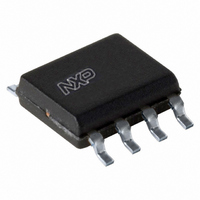SE95D,112 NXP Semiconductors, SE95D,112 Datasheet - Page 6

SE95D,112
Manufacturer Part Number
SE95D,112
Description
IC SENSOR TEMP 2.8-5.5V SOT96-1
Manufacturer
NXP Semiconductors
Datasheet
1.SE95DP118.pdf
(27 pages)
Specifications of SE95D,112
Function
Temp Sensor, Watchdog
Topology
ADC (Sigma Delta), Comparator, Register Bank
Sensor Type
Internal
Sensing Temperature
-55°C ~ 125°C
Output Type
I²C™
Output Alarm
No
Output Fan
Yes
Voltage - Supply
2.8 V ~ 5.5 V
Operating Temperature
-55°C ~ 125°C
Mounting Type
Surface Mount
Package / Case
8-SOIC (3.9mm Width)
Lead Free Status / RoHS Status
Lead free / RoHS Compliant
Other names
935274141112
SE95D
SE95D
SE95D
SE95D
NXP Semiconductors
SE95_7
Product data sheet
7.2 OS output and polarity
7.3 OS comparator and interrupt modes
7.4 OS fault queue
The OS output is an open-drain output and its state represents results of the device
watchdog operation as described in
external pull-up resistor is needed. The resistor should be as large as possible, up to
200 k , to minimize the Temp reading error due to internal heating by the high OS sinking
current.
The OS output active state can be selected as HIGH or LOW by programming bit
OS_POL of register Conf: setting bit OS_POL to logic 1 selects OS active HIGH and
setting to logic 0 sets OS active LOW. At power-up, bit OS_POL is equal to logic 0 and the
OS active state is LOW.
As described in
between register Temp data and the programmed limits, in registers Tos and Thyst, in
different ways depending on the selected OS mode: OS comparator or OS interrupt. The
OS mode is selected by programming bit OS_COMP_INT of register Conf: setting bit
OS_COMP_INT to logic 1 selects the OS interrupt mode, and setting to logic 0 selects the
OS comparator mode. At power-up, bit OS_COMP_INT is equal to logic 0 and the OS
comparator is selected.
The main difference between the two modes is that in OS comparator mode, the OS
output becomes active when Temp has exceeded T
below T
the state of the OS output; while in OS interrupt mode, once it has been activated either
by exceeding T
reading a register or putting the device into shutdown mode occurs, then the OS output is
reset.
Temperature limits T
output state will be undefined.
Fault queue is defined as the number of faults that must occur consecutively to activate
the OS output. It is provided to avoid false tripping due to noise. Because faults are
determined at the end of data conversions, fault queue is also defined as the number of
consecutive conversions returning a temperature trip. The value of fault queue is
selectable by programming the two bits OS_F_QUE[1:0] in register Conf. Notice that the
programmed data and the fault queue value are not the same.
one-to-one relationship between them. At power-up, fault queue data = 00 and fault queue
value = 1.
Table 3.
Fault queue data
OS_F_QUE[1]
0
0
1
1
hyst
Fault queue table
, reading a register or putting the device into shutdown mode does not change
Ultra high accuracy digital temperature sensor and thermal watchdog
os
Section
or dropping below T
os
Rev. 07 — 2 September 2009
and T
7.1, the OS output responds to the result of the comparison
hyst
OS_F_QUE[0]
0
1
0
1
must be selected so that T
Section
hyst
, the OS output will remain active indefinitely until
7.1. In order to observe this output state, an
os
and reset when Temp has dropped
os
Fault queue value
Decimal
1
2
4
6
> T
Table 3
hyst
. Otherwise, the OS
shows the
© NXP B.V. 2009. All rights reserved.
SE95
6 of 27















